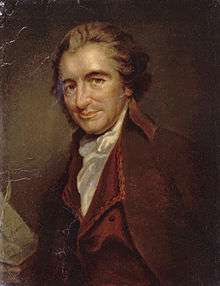Agrarian Justice

Agrarian Justice is the title of a pamphlet written by Thomas Paine and published in 1797, which proposed that those who possess cultivated land owe the community a ground rent,[1] and that this justifies an estate tax to fund universal old-age and disability pensions, as well as a fixed sum to be paid to all citizens upon reaching maturity.
It was written in the winter of 1795–96, but remained unpublished for a year, Paine being undecided whether or not it would be best to wait until the end of the ongoing war with France before publishing. However, having read a sermon by Richard Watson, the Bishop of Llandaff, which discussed the "Wisdom ... of God, in having made both Rich and Poor", he felt the need to publish, under the argument that "rich" and "poor" were arbitrary divisions, not divinely created ones.[2]
Proposed system
In response to the private sale of royal (or common) lands, Paine proposed a detailed plan to tax land owners once per generation to pay for the needs of those who have no land. This can be considered a precursor of the modern idea of citizen's dividend or basic income. The money would be raised by taxing all direct inheritances at 10%, and "indirect" inheritances – those not going to close relations – at a somewhat higher rate; this would, he estimated, raise around £5,700,000 per year in England.[3]
Around two-thirds of the fund would be spent on pension payments of £10 per year to every person over the age of fifty, which Paine had taken as his average adult life expectancy.
Most of the remainder would be used to make fixed payments of £15 to every man and woman on reaching the age of twenty-one, legal majority.
The small remainder of the money raised still un-used would be used for paying pensions to "the lame and blind".[4]
For context, the average weekly wage of an agricultural labourer was around 9 shillings, which would mean an annual income of about £23 for an able-bodied man working throughout the year.[5]
Philosophical background
The work is based on the contention that in the state of nature, "the earth, in its natural uncultivated state... was the common property of the human race"; the concept of private ownership arose as a necessary result of the development of agriculture, since it was impossible to distinguish the possession of improvements to the land from the possession of the land itself. Thus, Paine viewed private property as necessary while at the same time asserting that the basic needs of all humanity must be provided for by those with property, who have originally taken it from the general public. This in some sense is their "payment" to non-property holders for the right to hold private property.
See also
Notes
References
- Paine, Thomas. Agrarian Justice. Wikisource. (Paragraph 12).
- Paine, Thomas (2004). Common sense [with] Agrarian justice. Penguin. ISBN 0-14-101890-9.
- Bowley, A. L. (1898). "The Statistics of Wages in the United Kingdom During the Last Hundred Years. (Part I.) Agricultural Wages". Journal of the Royal Statistical Society. 61 (4). JSTOR 2979856.
External links
| Wikisource has original text related to this article: |
- "Thomas Paine's Agrarian Justice pamphlet". U.S. Social Security Administration. Archived from the original on 2016-03-03.
- Agrarian Justice in Collected Writings of Thomas Paine, on Google Books.